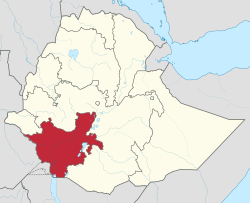Southern Nations, Nationalities, and Peoples' Region
This article needs to be updated. The reason given is: Succeeded by Central Ethiopia Regional State and South Ethiopia Regional State. Zones and districts have been re-organized. (September 2023) |
Southern Nations, Nationalities, and Peoples' Region
የደቡብ ብሔር ብሔረሰቦችና ሕዝቦች ክልል | |
|---|---|
Former regional state | |
 Map of Ethiopia showing Southern Nations, Nationalities, and People's Region (1992 to 2020 boundaries) | |
| Coordinates: 6°30′N 37°06′E / 6.5°N 37.1°E | |
| Country | |
| Administrative headquarters | Hawassa |
| ISO 3166 code | ET-SN |
The Southern Nations, Nationalities, and Peoples' Region (often abbreviated as SNNPR;
The SNNPR bordered
.The region dissolved when Sidama Region, Southwest Ethiopia Region, South Ethiopia Regional State and Central Ethiopia Regional State emerged independently.
In June 2020, following the formation of the Sidama Region the region's capital Hawassa is located outside of the boundaries of the region. The then regional government planned to move to a city within the region's boundaries after two consecutive national electoral cycles.[2] The largest cities in the region were Sodo with the population of 194,977 and Arba Minch with the population of 151,013.[3]
The dissolution of the region was certain when on 18 August 2023 the South Ethiopia Regional State was created following the 2023 South Ethiopia Region referendum with remainder of the SNNPR becoming the Central Ethiopia Regional State.
Demographics
This section needs to be updated. (December 2021) |
Based on the 2007 Census conducted by the
In the previous census, conducted in 1994, the region's population was reported to be 10,377,028 of whom 5,161,787 were men and 5,215,241 were women. At the time of the census, the rural population of the Region accounted for 93.2% of the total population.
were the three zones with the highest population. The population is concentrated mostly in eastern, northern and central part of the SNNPR while the western and southern part of the region is sparsely populated.The SNNPR Water Resources Bureau announced that as of the fiscal year ending in 2006, they had increased the area of the region that had access to
Values for other reported common indicators of the
| Year | Pop. | ±% |
|---|---|---|
| 1994 | 10,377,028 | — |
| 2007 | 14,929,548 | +43.9% |
| 2017 | 19,170,007 | +28.4% |
| source:[9] | ||
Religion
| Religion | 1994 Census | 2007 Census[4] |
|---|---|---|
| Protestants | 21.8% | 38.5% |
Orthodox Christians
|
34.6% | 41.86% |
| Muslim | 15.2% | 14.1% |
| Traditional religions | 26.4% | 2.4% |
Roman Catholics
|
3% | 3.2% |
| Other religious affiliations | — | 0.5% |
Ethnicities



The SNNPR, being an amalgam of the main homelands of numerous
| People | 1994 Census | 2007 Census[4] |
|---|---|---|
| Welayta | 12% | 10.59% |
| Hadiya | - | 7.98% |
| Gurage | 15% | 19.54% |
| Gamo | - | 7% |
| Kafficho | - | 5.44% |
Silt'e
|
- | 5.37% |
| Amhara | - | 4.10% |
- All ethnicities in region
The ethnicities native to the SNNPR, with percentages of the population as reported in the 2007 national census and organized by linguistic grouping, include:[4]
- Cushitic:
- Alaba special woreda
- Tembaro– 1.32%, mostly in Tembaro Woreda.
- Arbore – 0.04%
- Daasanach – 0.32%, mostly in Dasenech (woreda)
- Dirashe special woreda
- Dirashe special woreda
- Gedeo – 4.9%, mostly in Gedeo Zone
- Hadiya – 7.98%, mostly in Hadiya Zone
- Kembata Tembaro Zone
- Burji special woreda
- Konso special woreda
- Mareko(woreda)
- Sidama Zone
- Kebena
- Tsamai – 0.13%, mostly in Bena Tsemay (woreda)
- Nilo-Saharan:
- Bodi– 0.04%
- Kichepo
- Kwegu – 0.01%
- Me'en – 1%
- Mursi – 0.05%, mostly in South Omo Zone
- Nyangatom – 0.12%, mostly in Nyangatom
- Shabo, mostly in Keficho Shekicho Zone
- Shita people
- Suri/Surma – 0.17%, mostly in Surma (woreda)
- Omotic:
- Aari – 1.9%, mostly in Bako Gazer (woreda)
- Basketo special woreda
- Bench Maji Zone
- Chara – 0.08%, mostly in South Omo Zone
- Dawro – 3.28%, mostly in Dawro Zone
- Dime – < 0.01%
- Dizi – 0.23%, mostly in Maji (woreda)
- Dorze, mostly in Chencha (woreda)
- Gamo Gofa Zone
- Gamo Gofa Zone
- Hamar – 0.31%, mostly in Hamer (woreda)
- Kachama, mostly in Arba Minch (woreda)
- Karo– 0.01%
- Kafficho – 5.44%, mostly in Keffa Zone
- Konta special woreda
- Amaro special woreda
- Male – 0.59%, mostly in Male(woreda)
- Mello, mostly in Melokoza (woreda)
- Oyda – 0.25%, mostly in Oyda (woreda)
- Shakacho – 0.44%, mostly in Sheka Zone
- Sheko – 0.24%, mostly in Sheko (woreda)
- Welayta – 10.59%, mostly in Wolayita Zone
- Yem special woreda
- Semitic:
- Amhara – 4.10%, widespread
- Gurage – 17.57, mostly in Gurage Zone
- Silt'e Zone
- Lake Zwayarea
- Zergula
Languages
The 2007 census reported that the predominantly spoken mother tongue languages include
The 1994 census reported that the predominantly spoken languages include
Amharic is still the working language although most pupils get eight years of primary education in their home language and all secondary and further education is in English.[11]
Agriculture
The CSA reported that for 2004–2005 100,338 tons of coffee were produced in the SNNPR, based on inspection records from the Ethiopian Coffee and Tea authority. This represents 44.2% of the total production in Ethiopia.
Farmers in the Region had an estimated total 7,938,490 head of cattle (representing 20.5% of Ethiopia's total cattle), 3,270,200 sheep (18.8%), 2,289,970 goats (17.6%), 298,720 horses (19.7%), 63,460 mules (43.1%), 278,440 asses (11.1%), 6,586,140 poultry of all species (21.3%), and 726,960 beehives (16.7%).[12]
List of Chief Administrators
- Abate Kisho (SEPDM), 1992–2001[13]
- Hailemariam Desalegn, 12 November 2001 – March 2006[13]
- Shiferaw Shigute (SEPDM), March 2006 – July 2013[13][14]
- Dessie Dalke, July 2013 – 2018[14]
- Million Mathiwos, 2018 – 2019
- Erstu Yirdaw, 31 August 2019 – 18 August 2023
Administrative zones

The following table shows administrative zones and special woredas (an administrative subdivision which is similar to an
Former zones
See also
References
- S2CID 155079488.
- ^ "NEWS: SNNPRS Council approves legal framework which makes Hawassa city accountable to future Sidama Regional State". Addis Standard. 2019-10-18. Archived from the original on 2021-06-29. Retrieved 2021-06-16.
- ^ "Population Projection Towns as of July 2021" (PDF). Ethiopian Statistics Agency. 2021. Archived (PDF) from the original on 7 July 2022. Retrieved 31 May 2022.
- ^ a b c d e Central Statistical Agency: The 2007 Population and Housing Census of Ethiopia: Statistical Report for Southern Nations, Nationalities and Peoples' Region; Part I: Population Size and Characteristics Archived 2017-04-06 at the Wayback Machine. July 2010.
- ^ Population Projection of Ethiopia for All Regions At Wereda Level from 2014 – 2017. Federal Democratic Republic of Ethiopia Central Statistical Agency. Archived from the original on 6 June 2018. Retrieved 4 June 2018.
- ^ "Potable water expansion works underway with over 60mln birr in SNNP State". Walta Information Center. 28 November 2006. Archived from the original on 7 October 2007.
- ^ "SNNP State builds, repairs water facilities with over 94 mln birr". Walta Information Center. Archived from the original on 25 May 2011. Retrieved 2 March 2009.
- ^ Macro International Inc. "2008. Ethiopia Atlas of Key Demographic and Health Indicators, 2005." (Calverton: Macro International, 2008) Archived 2010-11-05 at the Wayback Machine, pp. 2, 3, 10 (accessed 28 January 2009)
- ^ "Southern Nations, Nationalities, and Peoples' Region population statistics". Archived from the original on 2018-09-24. Retrieved 2019-07-02.
- ^ "FDRE States-Basic Information, Southern nations and Nationalities". Archived from the original on 18 June 2008. Retrieved 10 May 2006.
- ISBN 978-94-007-7317-2.
- ^ "CSA 2005 National Statistics" (PDF). Tables D.4–D.7. Archived from the original (PDF) on 18 November 2008.
- ^ a b c "Ethiopia Regions". Worldstatesmen.org. Archived from the original on October 4, 2013. Retrieved October 1, 2013.
- ^ AllAfrica.com. Ethiopian Radio and Television Agency. July 13, 2013. Archivedfrom the original on May 25, 2015. Retrieved October 1, 2013.
- ^ "Names and codes for January 2000, Ethiopia". World Health Organization. Archived from the original on 2009-04-20. Retrieved 2020-10-05. The information in the WHO spreadsheet is built on information received 18 September 2002 from the Ethiopian Ministry of Federal Affairs.
External links
- Official website
- Map of Southern Nations, Nationalities, and Peoples' Region at UN-OCHA[PDFfile)
- Map of Southern Nations, Nationalities and Peoples' Region at DPPA of Ethiopia (PDF file)
- Ethiopia's Vanishing Tribes slideshow by Life magazine


